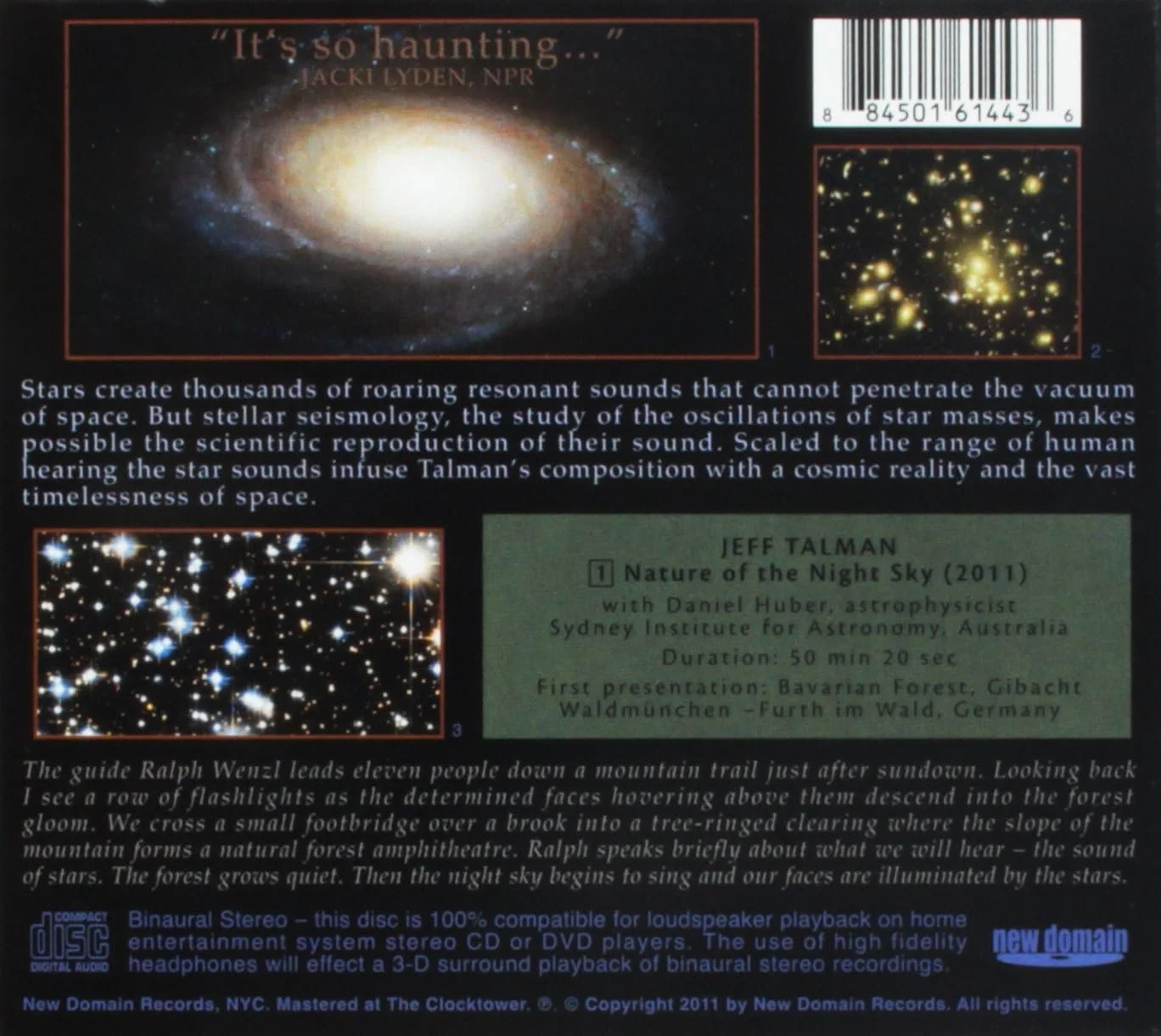Song for the Stars
The search for extraterrestrial sound started when listening to international artist Jeff Talman's debut CD, Nature of the Night Sky, which features the sounds of stellar resonance as its sole sound source. It is composed of star sounds modelled by astrophysicist collaborator Daniel Huber at the Sydney Institute for Astronomy.
Nature of the Night Sky, 2011
STAR DATA
The album relied heavily on radiation and seismic data from far away stars including the star Procyon in the constellation Canis Minor. All of which are transposed into sounds our ears can hear. And throughout the album, a total of 15 stars were sampled.
Here’s a preview of one of the tracks:
"After analysing the dense packs of resonance in Daniel's modeled star sounds, I filtered them to extract each star's principal resonant frequencies and then overlaid these to create the abstract, sonic-temporal forms of the work. The finished sound also features entire scaled resonant sound masses of a star" – Talman, 2011
Courtesy of Jeff Talman & Classical Music Sentinel
Music: Jeff Talman & Daniel Huber – In Your Stars (2018)
The sounds in this project are all based on astronomical observations of star oscillation. And all of the star sound data were scaled by a constant factor of one million to bring sounds into the range of human hearing.
Jeff Talman’s works have been featured on NASA, sharing his works as an art form that utilises cosmic sounds and data creatively to raise awareness on the sounds of space.
RANDOM COSMIC NOISE?
The universe is full of sounds. Some of which are documented online by NASA because of the sheer amount of resources they have. And most of the accompanying articles talk about how scientists managed to attain these data and how they’ve translated it to sounds we can understand. However, there seems to be a lack of further expository on how these sounds could potentially be signals from nearby civilisations. Most of such sounds have often been classed as “unusual” or “weird” and eventually dismissed as random cosmic noise.
In a National Security Agency (NSA) unclassified document by Lambros D. Callimahos (a US army cryptologist and a flute player) titled “Communication with Extraterrestrial Intelligence”, Lambros mentioned that “If another civilization were trying to establish communication with us, it would first embark on attention-getting signals of such a nature that we could distinguish them from random cosmic noise;”
He believes that a recognisable signal will be sent out and that way, we will know that someone out there is trying to communicate with us.
BUT Sound COULD BE PERCEIVED DIFFERENTLY
Much of the sounds from we hear from Earth that we deem as “signals” maybe esoteric in nature to those that do not belong to this planet in the first place.
And this could explain why NASA has had many failed attempts in sending Earth sounds into space hoping for a similar response. Could all of this be perceived as “random cosmic noise” to others out there as well? (Golden Record, Sounds of Earth played on Voyager 1 & 2)
In an article by Live Science, China has built a “Sky Eye” telescope that could have picked up signals from aliens out there. The claims went viral, spreading across Chinese media and social platforms before it even hit the press. But these findings were hit with lots of skepticism, saying that these signals, while “certainly artificial, they’re almost definitely from humans and not aliens”.
In the article, it has also mentioned that maybe these signals are not what we expect them to be. And maybe, it is because we do not have the technology to understand yet.
We expect civilisations out there to be similar to us, if not more advanced. The assumption is that they therefore have the capacity to perceive our signals as “communication signals” and send back sounds that we can perceive as “alien communication”.
There’s still lots we do not know, but one explanation for why we have yet to communicate with alien life is that we are just not that advanced enough to understand and grasp how life beyond Earth functions.
Ben Turner, 2022








